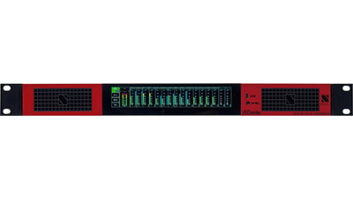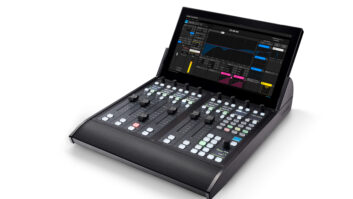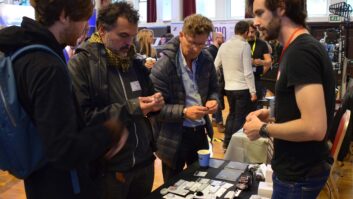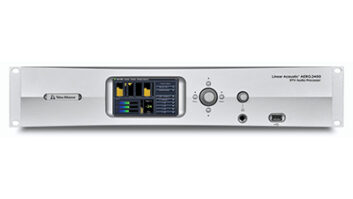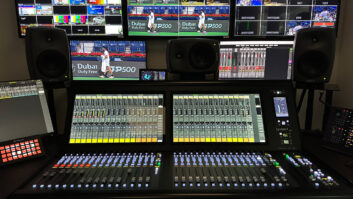The re-allocation of frequencies for wireless audio could have hidden consequences
With the switchover from analogue to digital transmission, the EU and national regulators are keen to sell off spectrum to mobile operators. However, this Digital Dividend will partly be paid for by the loss of frequencies for wireless microphone and talkback systems needed for outside broadcasts and other production use. David Fox talked to some of the companies affected
Generally, OB and hire companies are well prepared for the frequency changeover, which in the UK will mean moving from Channel 69 to Channel 38 for many licensed wireless microphone users by the middle of 2012. After all, television’s Digital Switch Over has been known about for several years. However, its medium term consequences are still unclear, especially once new, licence-free consumer services pop up in the white space between terrestrial TV channels.
Of course, it could be worse. It took a considerable industry effort over the past two years to ensure that broadcast users weren’t forgotten about by UK authorities. “The industry as a whole has been concerned about the future of radio mics after the DSO, and, fortunately it looks like PMSE (Programme Making and Special Events) users haven’t been overlooked – we’d like to thank all the groups and individuals who have campaigned long and hard,” said Paul Murray, head of audio, Presteigne Charter (pictured).
“We’ve always owned a lot of Sennheiser transmitters and receivers, right across the spectrum, many of which we’ll be sending back to Equiniti”, the organisation handling the transaction for regulator Ofcom, which will repay 55% of their replacement cost.
In fact, Presteigne Charter is disposing of more than 100 channels, a combination of handheld and belt-pack transmitters, many of which will need to be replaced. “We still have a lot of equipment that is not affected by the changeover – about 45 channels,” he adds. These have been bought in the last three years, in a lower licensable frequency range (590-790mHz), and before they knew there would be partial funding for the replacements.
“We tended not to use Channel 69 anyway, unless a client specifically requested it, in order to provide as robust a system as possible. If it was a big event, Channel 69 would be a bit crowded by news crews, etc, so the chance of interference was high,” he says.
Wait and see
“We decided not to purchase radio systems that we use on our contract for the cricket. We just hire from our suppliers so it becomes their problem,” says Hamish Greig, technical director, CTV Outside Broadcast, which is part of the Euromedia Group. CTV hires from lots of suppliers, particularly The Wireless Works and Presteigne Charter.
However, once it knows the new frequency arrangements work, and there are no problems, it will look again at buying new systems. “There’s no point buying now if it has to be exchanged after one or two years,” which is how long Greig feels it will be before things settle down and they know which frequencies work best and what equipment lives up to expectations.
CTV does have some of its own wireless systems, with 10 high-power radio microphones between Channel 63 and 69, “which currently covers us for 70-80% of golf courses we shoot at in Europe.” Only when those frequencies become compromised will it need to look at replacing them, and he is hopeful that the frequency change takes longer elsewhere in Europe than it is taking in the UK.
However, at least the UK regulator manages the frequencies it grants licenses for, whereas some countries provide nothing more than the licenses, and don’t check that there is any frequency available, he complains. This is why CTV usually does an RF recce before an event, sending two people to do a scan of the area, “because we are so dependent on radio and camera wireless systems. Until Europe cleans its act up frequency wise, we just have to make it work any way we can.”
For its cricket coverage it typically uses 10 or 12 radio microphones, plus three or four in-ear monitoring systems (used to talk to presenters, umpires and even some players during 20/20 competitions). For concerts and awards shows, the location often deals with the audio set up, so that when it has to it always hires.
Band of bothers
“Fortunately we do not have a large investment in band 69 RF gear – only six Sennheiser G2 mics and three IEM systems all of which we have had for a few years so it doesn’t really owe us anything,” says Arena Television’s head of sound, Tim Rowden.
“We did recently buy some new G3 gear for our new ESPN rugby contract [covering UK premiership matches], which was amongst the first band 38 gear to ship from Germany. I have to say it has been superb and exceeded expectations though when band 38 gets more crowded things may not be quite so easy,” he says.
“There is also the issue that parts of the country are not so band 38 friendly and JFMG [the PMSE frequency band manager] has produced an online map which is helpful with this,” says Rowden.
Arena bought nine G3 microphones (three personal, two stick and four plug-on units) and two IEM systems. “We chose the G3 systems largely because of cost and what the contract they are required for will support, and also because of our positive experiences with its G2 predecessor,” he explains.
“We will be eking out the old band 69 gear for as long as we can and then sell for what we can – probably abroad. At that point we will have to re-invest We have decided not to take up Ofcom’s offer to help with the cost of replacement […] as we felt that the extra two years of use coupled with the (albeit limited) disposal value would be roughly equivalent.”
The Wireless Works has hundreds of wireless systems, microphones and talkback, being used to cover a wide range of sports, light entertainment and major events, such as the recent royal wedding in London.
About half of its business is hire (and half of that involves supplying engineers along with the equipment), with the rest divided equally between sales and installations. Some 30% of its business is outside the UK.
It was set up after the likelihood of the frequency sell-off was raised, so it didn’t buy any equipment in that range, so it doesn’t have to upgrade. But, as it also sells wireless systems, its director, Tristian Bickerton, advises: “The more frequency agile the piece of equipment is, the more likely it is to be ordered. Some manufacturers have a very narrow tuning band, so we wouldn’t consider them for our customers.”
Frequency demands
Some typical OB applications, like sport, rarely demand a lot of frequency, unless it is an international event. Typically, Presteigne Charter might have five or six radio microphone channels at a football match or similar. Reality shows tend to be the most demanding. Something like The X Factor trial or the Britain’s Got Talent roadshow (which Presteigne does), where the shows tour the UK doing auditions, require about 24 channels.
Presteigne Charter also stocks varying sizes of antenna combiners and filters which are used on larger shows such as Fame Academy, which would require up to 40 radio mic channels, but there aren’t as many such shows currently.
It is looking to buy new UK frequency range (606-790mHz) microphones from Sennheiser, and has been waiting for them to come out.
The new equipment it has bought so far caters for an overall bandwidth of 184mHz, where it used to be 24mHz, and as it moves the switching bandwidths in house “the result will mean a lot less time consuming retuning” in their use.
Murray also likes that the new Sennheiser models can be easily adjusted and maintained using Sennheiser’s Wireless Systems Manager on a computer, and when a frequency is set on the transmitter it will automatically sync the receiver when held close.
Presteigne Charter is not going digital. “I don’t think the technology is quite there yet. It will need another few years,” says Murray. “Also, clients are still wary of it,” while Presteigne wants to keep all of its equipment the same “so that everything is compatible for a bigger job. We’ve got offices in Singapore and Germany and we need the agility to cover a lot of frequencies.”
“People mix up the digital dividend with changing form analogue to digital radio mics, but this is not the case,” adds Bickerton.
Although The Wireless Works has some digital talkback and radio microphone systems, “they all have their own unique issues” to overcome. “The idea that you can get more channels in the same frequency space is certainly not true,” he states.
Cognitive dissonance
Bickerton is more concerned about what will happen to the white space that is sold off, with the likes of Google wanting to buy it for use with short-range, license-exempt cognitive devices.
For example, he worries that when covering a concert, there will be hundreds of people contacting each other in a limited space via their Android or iOS devices “all on the same frequency as the main artist.” While each device may use low-power transmitters, having lots of them together so close to the audio systems could cause problems.
This was also a concern for JFMG when Ofcom consulted about the use of cognitive devices within interleaved spectrum two years ago. In its response, JFMG said: “After 2012 users of wireless microphones will be reliant almost solely on this spectrum.” While PMSE users will have to pay for access to interleaved, this spectrum would be free for cognitive devices. “Whilst we understand Ofcom’s rationale for exempting devices that are not deemed to cause undue interference to other spectrum users, this does not sit well with an industry who expect the cost of spectrum access to increase in the future. The lack of definitive proof that cognitive devices will not cause interference to licensed users within interleaved spectrum further exacerbates these concerns.”
Bickerton believes that wireless microphone and talkback manufacturers are also holding back on new developments because of these concerns, until the future is clearer.
“There is still enough spectrum to do what anyone wants to do,” he says, but he’s worried that the issue with cognitive devices will grow over the next few years, as companies like Google try to bypass the power of the mobile phone operators and fill up the spectrum with their own short-range communications applications. “In the next five years that will be the big threat to the wireless broadcasting industry.”
www.arena-tv.com
www.ctvob.co.uk
www.jfmg.co.uk
www.ofcom.org.uk
www.presteignecharter.com
www.thewirelessworks.biz

